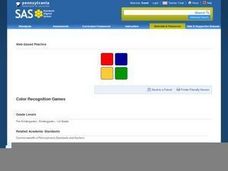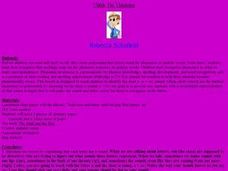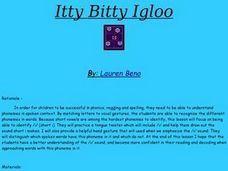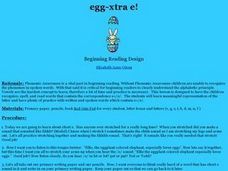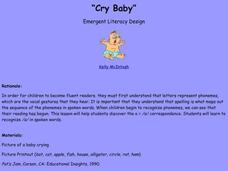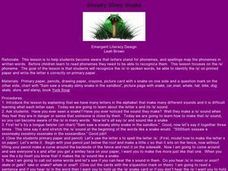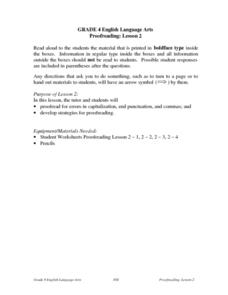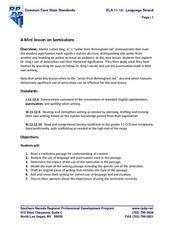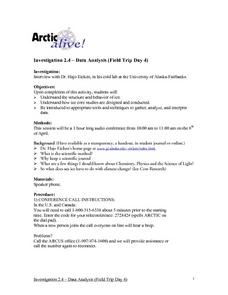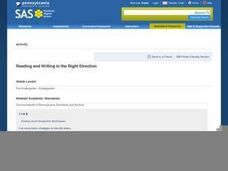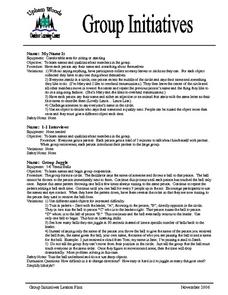Curated OER
Nancy's Nice Nose
Students recognize the phoneme /n/. Through matching activities, students discriminate the phoneme /n/ from similar looking letters and phonemes. They associate the phoneme /n/ with its letter representation and identify the phoneme /n/...
Curated OER
Elephants Enjoy Eating Eggs
Learners recognize the short vowel e in written and spoken language. Through listening and matching activities, they discriminate the vowel sound /e/ from other phonemes. Students practice using the phoneme and letter in words by writing...
Curated OER
Color Recognition Game
Students study color words. In this math lesson, students complete a variety of activities on the computer in which they identify colors and color words.
Curated OER
I'm Thinking
Students recognize the short vowel u in written and spoken language. Through matching and listening activities, they discriminate the vowel sound /u/ from other phonemes. Students associate the phoneme with its letter representation in...
Curated OER
Itty Bitty Igloo
Students recognize the short vowel i in written and spoken language. Through listening activities, they discriminate the vowel sound /i/ from other phonemes. Students associate the phoneme with its letter representation and identify the...
Curated OER
Egg-xtra E!
First graders recognize the short vowel e in written and spoken language. Through listening activities, they discriminate the vowel sound /e/ from other phonemes. Students identify the phoneme and letter in words and sentences they write.
Curated OER
Cry Baby
Students recognize the short vowel a in written and spoken language. Through matching and listening activities, they discriminate the vowel sound /a/ from other phonemes. Students associate the phoneme with its letter representation...
Curated OER
Sneaky Slimy Snake
Learners complete a variety of activities related to the /s/ phoneme. As a class they recite a tongue twister, then trace and write the letter S. Students then listen to word pairs and identify the word in each pair containing the /s/...
Curated OER
Parts of a Friendly Letter
The art of writing a letter has not been lost to email and texting! Teach kids how to format a friendly letter with a presentation about the parts of a letter, as well as prompting them to write a letter about their favorite holiday.
Curated OER
Proofreading: Lesson 2
Identify and develop strategies for proofreading with your class. They read and identify the grammar rules for capitalization, end punctuation, and commas, correct errors as a class, and complete three worksheets. This resource includes...
Southern Nevada Regional Professional Development Program
A Mini lesson on Semicolons
Dr. Martin Luther King, Jr.'s "Letter from Birmingham Jail" serves as an exemplar for a mini-lesson on semicolons. Working alone or in small groups, class members first circle all the semicolons in the letter, and then consider how this...
Curated OER
The Argument
After brainstorming, middle schoolers write an expository essay for a writing project. They focus on supporting points, organization, and writing conventions to develop a well-integrated paper. In addition, they revise, proofread and...
Scholastic
Collaborative Year-End Projects
Coming up with a menu of engaging year-end projects can be a challenge. Never fear, help is here with an article that suggests eight projects sure to capture the interest of learners of all ages.
Curated OER
Multisensory Sight-word Strategies
Students engage in a lesson that uses sight word strategies in order to increase reading comprehension. The skills are applicable to rote skill, math facts, formulas, etc... The lesson includes sample exercises for the teacher to use for...
Curated OER
SSSH - Successful, Simple Simulation, Hassle-Free
Students explore the Revolutionary War. They discuss ways to resolve conflicts, establish control/authority to meet needs. Students compare interactions among groups and then relate to other social groups. Students play a game to review...
Curated OER
Reading and Writing in the Right Direction
Beginning writers practice writing and reading from left to right using green and red dots. You'll need notecards with a green dot on the left side and a red dot on the right side. Do your learners understand that print moves from left...
Curated OER
If I Could Have Lived in Another Time or Culture
Third graders develop multi-paragraph compositions. They include an introduction, first and second level support, and a conclusion. They use a variety of sentence structures (e.g., simple, compound/complex) and sentence types (i.e.,...
Curated OER
Friendly Letter to a Leprechaun
Students write friendly letters. In this friendly letter writing lesson, students write a friendly letter to a leprechaun. Students review the parts of a friendly letter then watch the teacher model how to write a friendly letter,...
Alabama Learning Exchange
Making and Observing Life in a Terrarium
Young scholars understand the parts of the terrarium and why they are important in establishing an ecosystem. In this ecosystem lesson, students recall background information on aquariums, terrariums and the water cycle. Young scholars...
Curated OER
T'was the Night Before Christmas (Poem)
Students read the poem T'was the Night Before Christmas, and then partner with another student to complete a poem of their own based on the original. The new poem has missing words and students fill in the missing parts of speech like a...
Curated OER
Language Arts: Writing Skills Development
Students improve writing skills by expanding their self-perceptions. Next, they develop idea lists for writing topics. Their ideas become the basis for a class newspaper. following the creation of a group composition, students write...
Curated OER
PICTURE READING - PARAGRAPH WRITING
Young scholars investigate the elements found in a media image. The image is used to compose a descriptive paragraph. They exchange papers to discuss the writing and make changes using constructive criticism. Students also make...
Curated OER
Group Initiatives
Students explore the names and qualities about members in the group. They each say their name and something about themselves. Students gather around in a circle. They listen to the teacher as he or she says the name of someone and throws...




